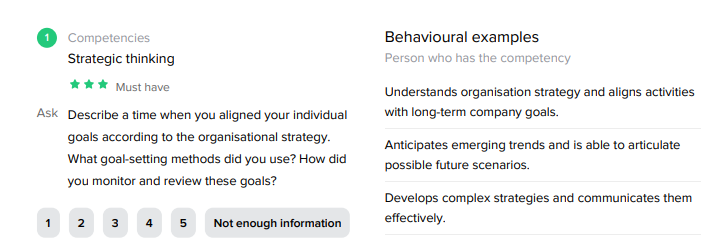How to use hiring scorecards
Learn how to understand and adjust scorecards, find candidates, and conduct effective interviews.
Hiring scorecards provide a structured and systematic approach to assessing and selecting candidates, making them a valuable tool to enhance the hiring process. By using ready-made scorecards, organisations can save time, maintain consistency, and improve the overall quality of their recruitment decisions.
Here's how to get the most from scorecards to make better, data-based hiring decisions.
Step I - Understand the position
The first step is to understand the position and what it takes to be successful, along with the overall profile of candidates.
Familiarise yourself with the scorecard. There is a lot of information there, and it’s critical you understand all aspects of it as you’ll be evaluating candidates based on the information within it.
All Wisnio Hiring Scorecards consist of three sections:
Key objectives - a description of the key objectives a candidate should accomplish to be considered successful;
Position requirements - the experiences and qualifications required to accomplish those objectives;
Competencies - the knowledge, skills, and abilities required to perform the job successfully.
All three are vital to successful hiring - each section solves a small piece of the puzzle, and together they form a detailed roadmap.
If you’re still not quite sure about the position after going through the scorecard, your best bet is to talk with people who either work or have worked at similar positions. They can give you insights and points of view that are hard to come by independently.
Once you feel confident you understand the position thoroughly, proceed to the next step - adjusting the scorecard.
Step II - Adjust the scorecard to your needs
No two companies are ever truly the same. They have different needs and wants depending on their strategy and the resources available to them.
We have put our best research and knowledge into the Hiring Scorecards, but changes based on your business reality are inevitable.
It’s important to understand that all elements in the Scorecards are connected and support each other. Thus, adding or deleting an aspect of it will most probably lead to changes in other parts of it.
For example, when you add a new objective, make sure that the position requirements and the competencies section include the experiences, skills, knowledge, and abilities needed to achieve that new milestone.
Example:
- Key objective:
Deals are moved through each sales pipeline stage following a consistent and
predictable process. - Position requirement
Sales Process Discipline - Demonstrated ability to methodically move
deals through the sales pipeline using a CRM, adhering to a structured and
repeatable process. - Supporting competencies
Planning and organising- It is important for a BDR to plan and prioritize work efficiently, manage time and resources effectively to ensure that deals are moved through the sales pipeline in an organized manner, adhering to a structured and repeatable process.
The key objective, position requirement, and competency are all connected and support each other to achieve the key objective. Change or delete the position requirement, and you risk making a hiring mistake, as all key objectives might not be properly assessed anymore.
When you feel confident that the scorecard reflects your business reality, you can move forward and actually start hiring.

Step III - Finding candidates
There are many ways to find candidates, from job advertisements to direct search and sourcing on LinkedIn, among others.
The main thing to remember is to use the requirements from the temscorecard during the candidate search process. The scorecards are designed to be used throughout the hiring process.
When using jobs ads, use the position requirements from the scorecard in the job ad.
A requirement for having a bachelor’s degree in marketing is not productive, but a proven ability to develop a clear product positioning strategy is as clear as it gets.
For more on improving the hiring process, read our article on it.
Step IV - The hiring interview
The objective of the interview is to gather unique information not found anywhere else that is relevant for evaluating candidates. As free-flowing conversations rarely lead to information needed for making an informed decision, our strong recommendation is to plan the interview ahead of time.
To help, all Wisnio Hiring Scorecards come with position-based interview questions and evaluation criteria to understand what to look for in the answers. Print out the scorecard and use it to guide the interview, ask questions, make notes, and score the candidates.
Use the same questions and scoring criteria for all candidates. Keeping interviews consistent enables you to later compare and contrast candidates in a bias-free and data-based manner.
Some general pointers for a productive candidate interview:
Focus on facts and past behaviours - Avoid asking questions about opinions of hypothetical situations. Instead, focus on factual achievements and examples of past performance in a similar situation.
Ask follow-up questions - Dig deeper into each situation by asking 2-3 follow up questions like “What was your specific role in the project?” and “What was the final outcome and how did you measure success?”.
Use the included scorecard - Write down your interview notes and ratings either during the interview or immediately after. To avoid groupthink, it’s essential to do that before discussing the candidate with other interviewers.
Conclusions
Wisnio Hiring Scorecards give you a detailed roadmap with everything you need to hire into critical roles.
You get a Success Profile with a description of all the necessary skills, experiences, qualifications, knowledge, and abilities needed to succeed in a given role.
We’ve worked hard to make the scorecards easy-to-follow and use. Using them comes down to four easy-to-follow steps:
Deeply understand the position
Adjust as needed
Find the right candidates
Conduct structured hiring interviews with the interview questions and evaluation criteria found in the scorecard
To get the most from the scorecards, we recommend using them with our decision tools that add a layer of team analysis and candidate-team fit critical to building high-performing teams.